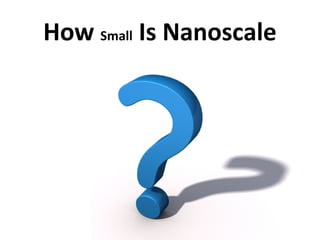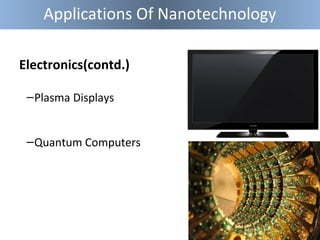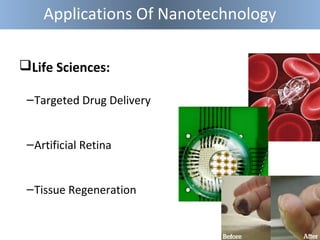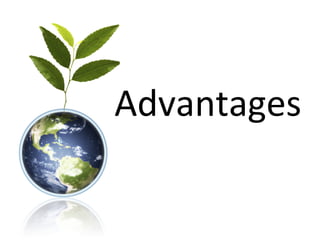NANOTECHNOLOGY
- 1. NANOTECHNOLOGY The Next Very BIG(small) thing
- 2. Agenda Introduction To Nanotechnology Nanotechnology In Today's Life Advantages Of Nanotechnology Disadvantages Of Nanotechnology Future Of Nanotechnology
- 4. What is Nanotechnology? Nanotechnology is science, engineering, and technology conducted at the nanoscale, which is about 1 to 100 nanometers.
- 5. How Small Is Nanoscale
- 6. How Small Is Nanoscale? A nanometer is… –one billionth of a meter Human DNA Sample: Approx. 2 nm Hair: Approx. 1x105 nm
- 8. Seeing at nanoscale Nanoscientists use high-powered microscopes that use unique methods to allow them to see the surface features on the atomic scale, effectively opening the door to modern nanotechnology such as scanning tunneling microscope and the atomic force microscope.
- 9. Manufacturing at the nanoscale Nanomanufacturing involves scaled-up, reliable, and cost-effective manufacturing of nanoscale materials, structures, devices, and systems. It leads to the production of improved materials and new products.
- 10. How it works? Encompassing nanoscale science, engineering, and technology, nanotechnology involves imaging, measuring, modeling, and manipulating matter at this length scale.
- 11. Who Cares About Nanotechnology ? We All Should Care! –Because it can bring revolution in the current industrialization and manufacturing processes.
- 13. Applications Of Nanotechnology Electronics: –Nano Transistors –Nano Diodes –OLED (Organic Light Emitting Diode)
- 14. Applications Of Nanotechnology Electronics(contd.) –Plasma Displays –Quantum Computers
- 15. Applications Of Nanotechnology Energy: –Batteries –Fuel Cells –Solar Cells
- 16. Applications Of Nanotechnology Materials: –Nano Tubes –Aerogel –Nano Particles
- 17. Applications Of Nanotechnology Life Sciences: –Targeted Drug Delivery –Artificial Retina –Tissue Regeneration
- 18. Advantages
- 19. Material With NT, we can create unique materials and products which are: – Stronger – Lighter – Cheaper – Durable – Precise Advantages
- 20. Advantages Industrial – Computers can become a billion times faster and a million times smaller – Automatic Pollution Cleanup –Manufacturing at almost no cost
- 21. Disadvantages
- 22. Disadvantages – Loss of jobs (in manufacturing, farming, etc) – Carbon Nanotubes could cause infection of lungs – Oil & Diamonds could become worthless – Atomic weapons could be more accessible and destructive
- 24. Future Of Nanotechnology Examples of Future Use of NT Electronic Paper Nokia Morph Contact Lens
- 25. Future Of Nanotechnology National Science and Technology Council (USA) claims that: “Nanotechnology is an enabling technology that will change the nature of almost every human-made object in the next century.”
- 26. THANK YOU
Editor's Notes
- In this presentation we are going to tell you, what actually nanotechnology is, how it is serving us in daily lives, what are its advantages and disadvantages and what the future of NT holds for us.
- so what is NT?
- by definiton as you can see ”it’s the art of manipulating matter at the nanoscale level”
- Now Here a question arises “how small the Nanoscale is?”
- 1. Its a bit difficult to realize how small the nano-scale is. To make things easier to get, we can say that one nanometre (nm) is one billionth of a metre. -2. Lets see some examples to make it clear In the picture on the right, we can see a man staring at his picked hair trying to figuring out the diameter of it, he will essentially come to the conclusion that a human hair is 100,000nm thick, while a DNA molecule is only 2 nms wide.
- We All Should care Because it can and most likely will bring revolution in the current industrialization and manufacturing processes.
- lets have a look how NT is leading us in different areas of expertise..
- e.g: in da field of electronics nanotransistors are becoming more nd more popular bcoz of it’s compactness.. If u are thinking that this is a single transistor then you need to reshape your thinking, bcoz this is a transistor box containing thousonds of transistors in it… Some other examples of nanoelectronics are Nanodiodes, OLEDs etc.
- The aapliances made with the help of nanoelectronics are getting its market share increasing and are becoming popular day by day due to the productivity and quality they have. Such as plasma Displays nd Quantum computing..
- 1-This is a nano-engineered battery, light in weight and flexible just like a paper. It can be rolled, twisted, folded or cut into a number of shapes with absolutely no loss of mechanical efficiency. Other energy suppliment examples with some change in their properties are fuel cells and solar cells
- 1-this rotating picture is actually a model of carbon nanotube, the strongest and stiffest materials discovered till to date. These tubes are the building block of almost all the NT objects. 2- Aerogel. The world’s lightest crystalline solid 3-and nano particles
- Apart from the engineering and science discussed so far, NT also has its applications in medical sciences 1- this picture shows the process of Targeted drug delivery.. Which will enable mankind to diagnose nd treat all the major diseases such as cancer, HIV etc. 2-. Artificial Retina and Tissue regeneration are the other examples of NT applications in life sciences..
- Although there are so many advantages to count about this incredible technology.. We are going to Highlight some of them……
- With NT, we can create unique materials and products which are: Stronger, Lighter, Cheaper, Durable and even Precise all at the same time
- 1- computers can become a billion times faster and a million times smaller.. 2- Automatic cleanup of Pollution.. 3- Manufacturing at almost No cost..
- Nothing is perfect in this World, so is NT..! Here are some of its disadvantages..
- Loss of jobs (in manufacturing, farming, etc) Carbon Nanotubes could cause infection of lungs Oil & Diamonds could become worthless Atomic weapons could be more accessible and destructive
- Now we are plugging into the future of Nanotechnology.
- 1- In future, you might be reading news on foldable electronic paper.. 2- This is the proto type of Nokia Morph concept phone based purely on NT.. 3- Contact lens that will let you check your blood sugar level by looking into a mirror. (It is expected to be coming in 5 years or so.
- This statement has obvious meaning that Nanotechnology is capable of changing the way almost everything is designed and made: from computers to clothing; from sports equipments to space ships and satellites; from cars to cancer therapies; from bridges to paint; and even objects and devices not yet imagined.

























